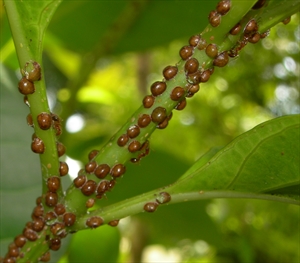Coffee brown scale, hemispherical scale
Pacific Pests, Pathogens and Weeds - Online edition
Pacific Pests, Pathogens & Weeds
Coffee brown scale (066)
Saissetia species. There are several species of Saissetia recorded in Pacific island countries. However, the species most often recorded on Annona in the South Pacific is Saissetia coffeae. The description below is for that species.
Asia, Africa, North, South and Central America, Europe, Oceania. It is recorded from Australia, Fiji, French Polynesia, Guam, Kiribati, Marshall Islands, Nauru, New Caledonia, New Zealand, Niue, Palau, Papua New Guinea, Samoa, Solomon Islands, Tonga, Vanuatu, and Wallis & Futuna. .
Wide; coffee, breadfruit, citrus, guava, soursop, ornamental plants, and especially cycads and ferns. In Hawaii, it is reported from orchids.
Females do not mate, males have not been found. About 500 eggs are laid under the body of the female, so they are protected. After hatching, the first immature stage, the crawlers, walk about to find a place to feed. Crawlers can also spread on the wind, as well as planting materials, and even on animals, including human beings. There are two other immature stages before the adult stage (Photos 1&2). The body of the adult expands into a shell-like structure, and the scale remains in place feeding and producing large numbers of eggs and nymphs. The adults live for about 8 days. The scale is said to prefer hot, dry conditions.
Damage is done in three ways:
- Injection of a toxin as the scale feeds causing spots on the foliage.
- Direct feeding causes leaves to be deformed, die early, or wilt, depending on the host. Infested fruits of soursop, for instance, are smaller than normal due to the scales' feeding.
- Sooty moulds develop which reduce photosynthesis, and plant vigour. Sooty moulds are fungi that grow on honeydew, the sugary substance discharged by sap-sucking insects, for instance aphids and some scale insects, as they feed (see Fact Sheet no. 51).
Look for the shiny, brown, dome-shaped adult scales, round to oval, about 2 mm across, most noticeable on the midrib on the undersides of leaves, on stems and fruits. They also occur on fruit stalks. Look for sooty moulds on leaves, and especially look for ants.
The scale remains attached to stems, branches and fruits even after death. So, it is important to find out if the scales are alive or not. Look to see if the infestation is spreading before applying any management practices.
NATURAL ENEMIES
There are a large number of parasitoids and predators known to attack Saissetia coffeae, but which ones are present in Pacific island countries is not known. Most of the parasitoids are tiny wasps, too small to be seen easily by the naked eye. (A parasitoid is like a parasite - which lives off its host - but, in the case of a parasitoid, it eventually kills it).
CULTURAL CONTROL
- Prune infested stems, branches and fruits and burn them.
- Apply mulch, manure or synthetic fertilizers to assist plant vigour.
- Destroy ant nests with boiling water, without damaging the plants infested with the scale insect; without the ants, parasitoids and predators will bring about natural control of the scale insect; alternately, use synthetic pyrethroids (see below).
- For trees, prune low branches and remove weeds to stop ants reaching leaves and fruits.
CHEMICAL CONTROL
Chemical control is not recommended because of the waxy surface of the scale. Also, insecticides are likely to kill any parasitoids and make biological control ineffective. However, if they are needed, either to kill the scale or ants, use the following:
White oil:
- 3 tablespoons (1/3 cup) cooking oil in 4 litres water.
- ½ teaspoon detergent soap.
- Shake well and use.
Soap:
- Use soap (pure soap, not detergent).
- 5 tablespoons of soap in 4 litres water, OR
- 2 tablespoons of dish washing liquid in 4 litres water.
Commercial horticultural oils (made from petroleum) can also be used; follow the instructions on the product label. White oil, soap and horticultural oil sprays work by blocking the breathing holes of insects causing suffocation and death. Spray the undersides of leaves; the oils must contact the insects. The addition of malathion is useful against scales insects.
A second application of soap or white oil may be necessary after 3-4 weeks.
Use synthetic pyrethroid insecticides to kill ants; these insecticides may also be tried against scale insects, as they are likely to be effective against the crawlers - crawlers are the young active nymphs which spread infestations to new plants and/or new gardens.
____________________
When using a pesticide, always wear protective clothing and follow the instructions on the product label, such as dosage, timing of application, and pre-harvest interval. Recommendations will vary with the crop and system of cultivation. Expert advice on the most appropriate pesticides to use should always be sought from local agricultural authorities.
AUTHORS Helen Tsatsia & Grahame Jackson
Information from MAF Plant Health & Environment Laboratory (2011) Hemispherical Scale (Saissetia coffeae): PaDIL - http://www.padil.gov.au; and CABI (2019) Saissetia coffeae (hemipherical scale). (https://www.cabi.org/cpc/datasheet/48202); and Saissetia coffeae. Wikipedia. (https://en.wikipedia.org/wiki/Saissetia_coffeae); and from Saissetia coffeae (Walker). Hemispherical scale. Manaaki Whenua. Landcare Research. (https://www.landcareresearch.co.nz/discover-our-research/biodiversity/plants-invertebrates-fungi-and-bacteria/invertebrate-systematics/scale-insects/factsheets/saissetia-coffeae/)
Produced with support from the Australian Centre for International Agricultural Research under project PC/2010/090: Strengthening integrated crop management research in the Pacific Islands in support of sustainable intensification of high-value crop production, implemented by the University of Queensland and the Secretariat of the Pacific Community.





